Machynlleth is a market town and community in the county of Montgomeryshire, situated in the Dyfi Valley at the intersection of the A487 and the A489 roads. The town has ancient origins and was the seat of Owain Glyndŵr’s Welsh Parliament in 1404. The town lies some eight miles from the Cardigan Bay coast. The men of Machynlleth who fell during both World Wars are commemorated on the town’s Cenotaph, which is situated in a prominent position at the junction of Heol Penrallt, Heol-Y-Doll and Maes Glas. The memorial takes the form of a cenotaph like structure, topped with crucifix, with the sarcophagus supported by four brown marble columns with elaborate finials. A large bronze plaque at its centre shows the dedication and the names of the fallen of the Great War, whilst an additional plaque was added after World War Two, to commemorate the men of the town who fell during the latter conflict. The memorial was unveiled by The Marquess of Londonderry on 10 April 1924.
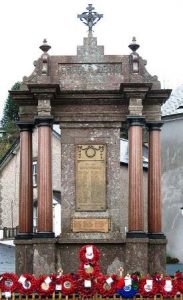
The Great War, 1914-1918
Thomas Arnold, Private, 39053, South Wales Borderers. Thomas was the son of David Arnold and Mary Arnold (nee Davies), of Pantlludw Cottages, Machynlleth. Thomas worked as a waggoner before the war. He enlisted into the Royal Welsh Fusiliers at Machynlleth, and in the summer of 1917 was drafted to France, where he was transferred to the 1st Battalion, South Wales Borderers. The battalion was attached to 3 Brigade, 1st Division and had been on the Western Front since the outbreak of the war. Thomas joined the 1st SWB at Le Clipon camp, near Coxyde, on the Channel coast, where the 1st Division had been preparing for a possible offensive. The Passchendaele offensive had, however, stalled in the Flanders mud, so the 1st Division was one of several transferred from the coast to the Ypres Salient, in an attempt to make a breakthrough. The 1st Division moved into camps near Poperinghe by 1 November and the men trained in preparation to move into the line. On 8 November the 1st SWB moved out of camp and marched to its new positions at Irish Farm, where the men spent an unpleasant night under shellfire in the trenches for the first time in months. On the following morning the battalion received orders to take up positions in readiness for an assault and formed up along a 200-yard frontage west of Valour Farm, with their objectives being Virtue Farm, Virile Farm, Vocation Farm, Box Farm and Void Farm, with a number of pillboxes at Goudberg Copse also being targeted. At dawn on 10 November 1917 the battalion launched its assault in terrible conditions. Thomas was killed at some time during the day. The 26-year-old has no known grave and is commemorated on the Tyne Cot Memorial, Belgium.
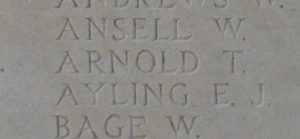
George Arthur Caffrey, Private, 201266, Tank Corps. George was the son of George Caffrey and Minnie Caffrey (nee Easton), of Old Maengwyn, Machynlleth. He enlisted into the army at Coventry and was originally posted to the Machine Gun Corps. After training as a specialist machine-gunner, George was transferred to the secretive Machine Gun Corps (Motors) and trained in the newly designed tanks. The Battle of the Somme opened on 1 July 1916 and apart from the odd breakthrough, many lives were lost for scarcely any gain. As a result, it was decided to use the new top-secret tanks in action for the first time, and on 14 July a large number of tanks were moved forwards into the battle area near Trônes Wood. George became one of the first tank crewmen in action when he took part in the famous Battle of Flers-Courcelette on 15 September when the great machines advanced from positions at Delville Wood. George was wounded during the assault after his tank caught fire and was evacuated home, where he became engaged to Miss Katie Jones, of Machynlleth. During May 1917 he returned to France, and was posted to the 7th Battalion, Tank Corps. He saw further action during the Battles of Messines Ridge and then at Passchendaele. George would then have taken part in further fighting during the epic defensive actions which followed the launching of the German Spring offensives of March and April 1918. The next major tank action was during the Battle of Amiens on 8 August 1918, when a combined British, Australian and Canadian assault, supported by tanks, broke the will of the German army at Villers-Bretonneux, laying the foundations for a general assault along most of the Western Front on 21 August. The 7th Battalion had been at Blangy, near Arras whilst this drama had played out on 8 August, before moving to positions at Bienvillers-au-Bois to take part in the great offensive. Heavy fighting was seen during the coming days before the tanks were withdrawn to rest and refit on 26 August. On 1 September the Germans counter-attacked and the 7th Battalion was ordered forward to support the infantry at Beugnatre. George was killed in action on the following day, 2 September 1918 when his tank was destroyed by German artillery fire whilst supporting an assault by the 5th Division on Beugny. The 24-year-old is buried in Vaulx Hill Cemetery, France.
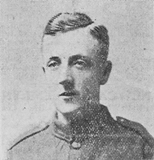
Thomas Cudworth, Private, 61305, Royal Welsh Fusiliers. Thomas was the son of John Thomas Cudworth and Gwen Lloyd Cudworth (nee Jones), of 22, Snowdon View, Machynlleth. He worked as a fireman for the Cambrian Railways prior to the war. Thomas enlisted into the army at Machynlleth in February 1917 and after completing his training was drafted to France in the summer of 1917, joining the 17th Battalion, Royal Welsh Fusiliers, which was at Ypres attached to 115 Brigade, 38th (Welsh) Division. On 31 July 1917 the Division took part in its famous assault on the Pilckem Ridge, capturing Iron Cross and reaching its objective of the Steenbeek, then played a supporting role in the Battle of Langemarck. The Division was transferred to the Sailly-sur-la-Lys sector in September and remained in the area over the winter before being moved to positions north of Albert, at Bouzincourt Ridge, at the end of March 1918, relieving the battered 2nd and 47th Divisions. It held this sector, again carrying out minor operations and trench raids, over the coming months, before taking part in the great offensive of 21 August 1918, and began its advance towards the Hindenburg Line. On 31 August the 17th RWF enjoyed a well-earned rest, after an advance which had seen the Division cross the entire Somme battlefield of 1916, then on the following day, 1 September 1918, took part in an assault against the heavily fortified village of Morval. The battalion attacked on the right flank, from the direction of Sailly-Saillisel and took a large number of prisoners during the day. Sadly, Thomas had been killed during the assault that day. The 21-year-old has no known grave and is commemorated on the Vis-en-Artois Memorial, Haucourt, France.
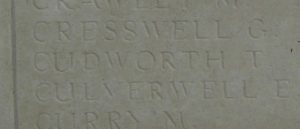
Reverend Emlyn Holt Davies, B.A., B.D., Chaplain, Young Men’s Christian Association. Emlyn was born on 19 April 1876, the son of David Edward Davies and Mary Davies (nee Holt), of Machynlleth. He was educated at Bangor and at New College, London, before becoming a Missionary in India. He returned to England after suffering from ill health and married Winifred Williams, of Talybont, on 29 March 1901, the couple having three children. In November 1917 Emlyn became Curate of Westport Congregational Church, Malmsbury, and the family moved to The Manse, Westport, Malmsbury, Wilts. Emlyn then volunteered to serve in France and on 8 January 1918 became attached to the Indian Labour Corps. His ill health soon returned, however, and he died of meningitis on 18 March 1918, aged 41. He is buried in Cerisy-Gailly Military Cemetery, France.
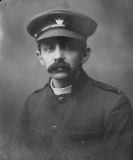
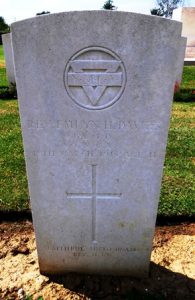
Jethro Davies, Corporal, 10507, Royal Welsh Fusiliers. Jethro was the son of Thomas and Mary Davies, of 29, Greenfield Street, Machynlleth. He worked as a farm labourer prior to enlisting into the 3rd Battalion, Royal Welsh Fusiliers at Machynlleth on 27 October 1910 and was posted to the barracks at Wrexham. After completing his basic training, Jethro was posted to India to join the 1st Battalion, Royal Welsh Fusiliers. The battalion sailed from India for England on 3 September 1914, and joined 22 Brigade, 7th Division at Lyndhurst, before the entire Division embarked for the front, landing at Zeebrugge on 7 October 1914. The 7th Division had gone to Zeebrugge to defend the port, but it was already in the process of falling to the Germans, so the 7th Division moved out of the city, marching via Bruges to Ostend, where the Division then entrained for Ghent. The Division then marched to Meirelbeke, and dug in defensive positions, in support of the French and Belgians. It soon became apparent that the Germans had broken through the Belgian lines, so on 11 October the 7th Division received orders to withdraw, reaching Hansbeke by the following day, and over the coming days continued to withdraw, marching through Thielt to Roulers, and by 14 October reached Ypres, becoming the first British Division to hold the city. The remainder of the BEF moved to Ypres from the Marne soon afterwards, in time to take part in the desperate defence of Ypres, when the Germans began attacking the city on 19 October. The Division saw terrible fighting over the coming weeks, before settling down for the first winter on the Western Front. Jethro was shot in the arm and wounded during the first major action of the following year, at Neuve-Chapelle on 13 March 1915 and evacuated by the 7th Casualty Clearing Station at Merville to hospital at Boulogne. Upon his recovery he re-joined the battalion in time to take part in the Battle of Aubers Ridge, where the Division launched an assault against the village of Aubers on 9 May 1915. The 1st RWF remained in the assembly trenches, in support of the assault, but the attacking troops made no gains, so the battalion was not called upon, and marched to billets in Essars. On 15 May 1915 the 7th Division took part in another assault, against the village of Festubert. The 1st RWF attacked on the following day, 16 May 1915, ordered to seize the line running from the Rue Quinque to Rue D’Ouvert. The battalion seized the German front and second lines but suffered terrible losses in doing so. After rebuilding again, the next major action came during the Battle of Loos on 25 September 1915. The 1st RWF launched their assault from Vermelles that morning, but came under withering machine-gun and artillery fire, suffering over 400 casualties during the day. Jethro was among the dead that day. The 22-year-old has no known grave and is commemorated on the Loos Memorial, France. His brother, Lewis, died in 1918 of wounds suffered in Palestine.
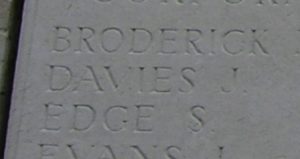
Lewis John Davies, Lance Corporal, 355817, Royal Welsh Fusiliers. Lewis was the son of Thomas and Mary Davies, of 29, Greenfield Street, Machynlleth. He worked as a carter prior to enlisting into the Welsh horse Yeomanry at Newtown on 8 March 1915. The Welsh Horse Yeomanry had formed in August 1914 in the southern counties of Wales, before moving its HQ to Newtown. By early 1915 it moved to Norfolk, joining the 1/1st North Midland Mounted Brigade, 1st Mounted Division in the Diss area. During September 1915 the Division dismounted and sailed from Liverpool aboard the SS Olympic on 25 September, landing at Anzac Cove, Gallipoli on 10 October 1915 where the Welsh Horse became attached to the 54th Division. The Division was evacuated to Egypt in December 1915 and the Welsh Horse was put on the Suez Canal Defences until July 1916, before joining the Western Frontier Force. On 4 March 1917 the battalion merged with the Montgomeryshire Yeomanry to form the 25th (Montgomery & Welsh Horse Yeomanry) Battalion, Royal Welsh Fusiliers, as part of the newly formed 231 Brigade, 74th (Yeomanry) Division. The Division assembled in Egypt as part of the EEF, before crossing the Suez Canal into the Sinai, and saw its first major action during the Second Battle of Gaza. The battle was a failure, and the EEF was re-organised under a new commander, Sir Edmund Allenby, before launching the Third Battle of Gaza on the night of 31 October 1917. This assault was launched along a winder front, running from Gaza to Beersheba, and this time the EEF prevailed, opening the door to Jerusalem, which surrendered on 8 December. Lewis had been wounded in the face on 30 November and was evacuated to hospital in Alexandria. After several months in hospital, he was deemed as fit enough to return home, but was still seriously ill. He was then taken to the King George Hospital, Lambeth where he died of a combination of his wounds and pneumonia on 26 October 1918. The body of the 22-year-old was brought home and he was buried in Machynlleth Nonconformist Cemetery. His elder brother, Jethro, had been killed at Loos three years earlier.
Robert Davies, Lance Corporal, 705, Royal Welsh Fusiliers. Robert was the son of Richard and Elizabeth Davies, of Barracks, Machynlleth. He had enlisted into the 7th Battalion, Royal Welsh Fusiliers prior to the war. The battalion was a Territorial unit, which mobilised for war at Newtown in August 1914, as part of North Wales Brigade, Welsh Division and moved to Conway until the end of the month, before moving to Northampton. In December the Division moved to Cambridge and then in May 1915 to Bedford, where the Division was numbered and the formation became 158 Brigade, 53rd (Welsh) Division. On 19 July 1915 the entire Division sailed from Devonport for Imbros and on 9 August 1915 landed at Suvla Bay. The infantry moved off the beaches across the Salt Lake, under shellfire, into the scrub covered Chocolate Hill, but due to a lack of maps and no knowledge of the terrain, many of the units became disorientated, and the situation became chaotic. After the fighting died down, the winter rolled in, and the men first had to endure torrential downpours, which flooded the trenches, before the snow hit, and many men began falling ill in the terrible conditions. Robert was shot in the spine and evacuated by Hospital Ship to St. George’s Hospital at Malta at some time after the landings. He died of his wounds in hospital there on 20 December 1915. The 19-year-old is buried in Pieta Military Cemetery, Malta.
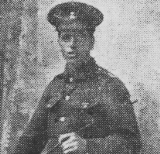
Thomas Owen Davies, Lance Corporal, 428278, Canadian Infantry. Thomas was born on 14 February 1893, the son of Owen Davies and Mary Ann Davies (née Hurley), of Garden Village, Machynlleth. The family later resided at 55, Bridge Street, Aberystwyth, while Thomas migrated to Canada at some time after 1911. He enlisted at New Westminster, British Columbia on 7 April 1915 into the 7th Battalion, Canadian Infantry. He sailed for England with his battalion on 13 November 1915 and after training on Salisbury Plain the Canadians moved to France. Thomas served at Ypres and on the Somme with the battalion before his health began to fail and he was transferred to the Canadian Forestry Corps in February 1918. He was later found to have contracted tuberculosis and returned to Canada for treatment before returning to Wales after the war. Thomas died at Machynlleth on 1 March 1921, aged 29 and was buried in Penegoes Churchyard, Machynlleth. His case was submitted to the CWGC on 5 December 2016, and he was accepted for commemoration on Tuesday 20 December 2016. He was reported to have been awarded the Distinguished Conduct Medal for his gallantry during a German gas attack at Ypres on 3 June 1916, for bringing in wounded men whilst under heavy rifle and machine-gun fire, but the award cannot be traced.
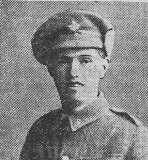
Evan John Ellis, Private, 12243, Welsh Regiment. Evan was the son of John and Catherine Ellis, of Maesglas, Machynlleth. He worked for the Fochriw and Dowlais Collieries as a contractor prior to the war and lodged at 10, Mount Pleasant, Pentwyn, Fochriw. Evan enlisted into the 8th Battalion, Welsh Regiment soon after the outbreak of war. The battalion formed at Cardiff in August 1914, moving to Parkhouse, Salisbury Plain to join 40 Brigade, 13th (Western) Division. The Division then moved to Chiseldon before spending the winter in billets in Bournemouth in billets. During January 1915 the 8th Welsh was converted to the Pioneer Battalion for the 13th Division and on 15 June 1915 sailed from Avonmouth for Mudros, before landing at Anzac Cove on 5 August 1915, in time to support the Anzac offensives. Although a Pioneer unit, the 8th Welsh was thrown into the offensive as infantry and suffered heavy casualties over the coming days during a gallant attempt to capture Chunuk Bair. The Division remained on the Gallipoli Peninsula as winter rolled in and suffered a great many casualties through the dire weather conditions. The Division was evacuated in December 1915 and moved to Egypt, then in February 1916 it was transferred to Mesopotamia, to take part in the efforts to relieve General Townshend’s besieged garrison at Kut. Conditions here was also terrible, with malaria and other tropical diseases rife. Evan died in Mesopotamia on 19 July 1916. The 28-year-old is buried in Amara War Cemetery, Iraq.
David William Evans, MM, Second Lieutenant, Royal Welsh Fusiliers. David was the son of William R. and Grace Evans, of Tan-Y-bwlch Terrace, Blaenau-Ffestiniog. He came to Machynlleth to work for the National and Provincial Bank. David enlisted into the Royal Welsh Fusiliers soon after the outbreak of war and was drafted to France on 24 June 1916, joining the 16th Battalion, Royal Welsh Fusiliers. The battalion was attached to 113 Brigade, 38th (Welsh) Division and was preparing to launch its famous assault on Mametz Wood when David joined its ranks. The first attack on the wood was launched on a two-battalion front on 7 July, but failed, and the Divisional Commander, Sir Ivor Philipps, was replaced before the Division attacked again on a two Brigade front on 10 July 1916. After two days of ferocious hand-to-hand fighting, the wood was cleared up to its northern edge, before the battered Division was relieved. It then took over a section of the front at Hébuterne before moving to the Ypres Salient and taking over the Canal Bank sector at Boesinghe. The infantry battalions of the Division then began carrying out the normal pattern of rotation in the trenches, four days in the front, four in support and four in reserve, whilst also working on trench improvement, digging new trenches, and also carrying out regular patrols and trench raids. On 31 July 1917 the Division launched its famous assault on the Pilckem Ridge, capturing Iron Cross and reaching its objective of the Steenbeek, then played a supporting role in the Battle of Langemarck. The Division was transferred to the Sailly-sur-la-Lys sector in September and remained in the area over the winter. By November 1917, David had been awarded a commission and was sent home to attend an officer cadet school. He had also reportedly been awarded the Military Medal just prior to this, although no trace of its award has been found. On 28 May 1918 the newly commissioned David landed in France again to join the 2nd Battalion, Royal Welsh Fusiliers. He was subsequently attached to the 14th Battalion, Royal Welsh Fusiliers, which was attached to 113 Brigade, 38th (Welsh) Division. The Division had moved to positions north of Albert, at Bouzincourt Ridge, at the end of March 1918, relieving the battered 2nd and 47th Divisions. It held this sector, again carrying out minor operations and trench raids, over the coming months, before taking part in the great offensive of 21 August 1918, and began its advance towards the Hindenburg Line. Over the coming weeks the Division drove forwards at a remarkable rate, and by 7 October 1918 had reached the strongly defended Mortho Wood, which formed part of the Beaurevoir Line. During the following morning, 8 October 1918, the Division launched a frontal assault on Mortho Wood, supported by a number of tanks. David was killed in action during the assault that morning. The 24-year-old is buried in Bois-Des-Angles British Cemetery, Crevecoeur-Sur-L’Escaut, France.
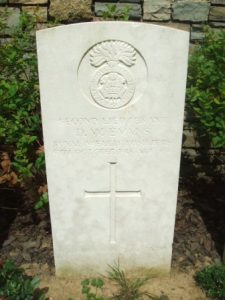
Edward Evans, Private, M2/226786, Royal Army Service Corps. Edward was the son of Edward and Hannah Evans, of 23, Pentrehedyn Street, Machynlleth. He enlisted into the Army Service Corps and was posted to the Middle East, before joining the 729th Motor Transport Company, Army Service Corps in Mesopotamia in 1916. Edward served overseas for three and a half years but took ill whilst on board ship in the Mediterranean during the voyage home. He was hospitalised in Malta where he died of influenza on 18 February 1920. The 23-year-old is buried in Pieta Military Cemetery, Malta.
Hugh Phillip Evans, Private, 235410, Royal Welsh Fusiliers. Hugh was the son of Hugh and Ann Evans, of Machynlleth. Hugh left Machynlleth after gaining a post as Stationmaster at Boughrood, Radnorshire for the Cambrian Railways. He married Violet Roselle Stephens, a school mistress from Penally, there on 19 January 1908 and the couple had a son, Philip, born on 2 April 1908. Hugh enlisted into the Brecknockshire Battalion, South Wales Borderers on 2 September 1914 and was posted to Pembroke Dock with the battalion. When the front-line battalion embarked for overseas, Hugh initially remained in Pembrokeshire with the 3/1st Brecknock’s. On 16 June 1917 he embarked for France and was posted to the 14th Battalion, Royal Welsh Fusiliers, which was at Ypres attached to 113 Brigade, 38th (Welsh) Division. Hugh joined the battalion behind the lines on 8 July, while it was training in preparation for an assault by the 38th Division on the Pilckem Ridge. On 31 July 1917 the Division launched its famous assault on the Pilckem Ridge, capturing Iron Cross and reaching its objective of the Steenbeek, then played a supporting role in the Battle of Langemarck. Hugh was killed in action whilst the 14th RWF was holding the newly captured line near the Steenbeek on 4 August 1917, just prior to the battalion being relieved. The 39-year-old has no known grave and is commemorated on the Ypres (Menin Gate) Memorial, Belgium.
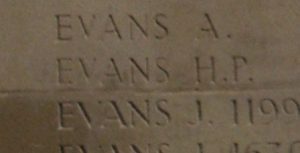
John Rowland Evans, Private, 291699, Royal Welsh Fusiliers. John was the son of John Robert Evans and Anne Evans (nee Jones), of Tŷ Uchaf, Llanbrynmair. He worked as a waggoner on his fathers’ farm prior to the war. John enlisted into the 7th Battalion, Royal Welsh Fusiliers at Machynlleth on 11 December 1915 and was placed on the Army Reserve. He was mobilised on 23 May 1916 and posted to Park Hall Camp, Oswestry for training. John took ill whilst at Oswestry, and was diagnosed as suffering from Scarlet Fever, so was sent to the Isolation Hospital, at Chester. He died there of Scarlet Fever on 14 January 1917, aged 21. John is buried in Llanbrynmair Congregational Chapelyard, Dolfach.
William Ashton Evans, Second Lieutenant, Cheshire Regiment. William was the son of William Henry Evans and Sarah Evans, of Brickfield Terrace, Machynlleth. He trained as a teacher and had been offered the post of master of a school in London prior to the war. Unfortunately, war erupted in August 1914 and William enlisted into the army soon afterwards, joining the 16th Lancers. William embarked for France on 12 October 1915 and his intelligence and bravery was soon recognised as he was sent home to attend an officer training school, from which he was commissioned as Second Lieutenant into the Cheshire Regiment. William embarked for France once more, joining the 9th Battalion, Cheshire Regiment on 11 September 1916. The battalion was attached to 56 Brigade, 19th (Western) Division and was rebuilding near Strazeele following heavy losses during the initial days of the Somme offensive. By 9 October 1916 the Division had moved south again, back to the Somme sector, in order to join in with the continued fighting there. The Division was stationed initially around Hébuterne, before eventually taking over trenches northeast of Thiepval by 23 October and took part in the latter stages of the Somme offensive, during the Battle of the Ancre. The 9th Cheshire’s were at Aveluy on 15 November when their lines were subjected to a heavy artillery bombardment. William was seriously wounded in the head and legs and was evacuated to a Field Ambulance at Contay, where he died of his wounds on the following day, 16 November 1916. The 28-year-old is buried in Contay British Cemetery, Contay, France.
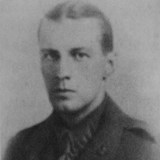
Harry Fletcher. Harry cannot presently be identified.
David Griffiths, Private, 73954, Sherwood Foresters. David was the son of Thomas Griffiths and Mary Griffiths (nee Beedle), of Haulfan, Ffridd Gate, Machynlleth. The family was living at 4, Railway Side, Porth prior to the war, and David worked there as a warehouseman. He enlisted at Cardiff into the 3rd Battalion, Welsh Regiment on 6 March 1917 and upon completing his training was posted to No 5 Infantry Base Depot in France in May 1917, initially destined for the 18th Welsh. He was, instead, posted to the 19th Welsh on 19 June 1917. The battalion was in the Canal Bank sector at Ypres, with the 38th (Welsh) Division, and was building up ready to launch an assault on the Pilckem Ridge on 31 July. David survived the carnage of the Battle of Pilckem Ridge, and when the Division was relieved from the Ypres sector, he was transferred to the 10th Welsh. The Division then moved to positions near Armentieres and took over a sector at Sailly-sur-la-Lys for the winter. The army was re-organised in at the end of January 1918, and the 10th Welsh received the unwelcome news that it was to be broken up, and its officers and men sent to rebuild other depleted units. David was initially posted to No 1 Entrenching Battalion on 27 February, and then on 1 April 1918 was posted to the 2nd Battalion, Sherwood Foresters, which was attached to 71 Brigade, 6th Division. The Division had suffered terrible casualties during the German Spring offensive and had just been moved to the Lys sector to rest but became caught up in the second phase of the German Spring offensive, which was launched on the Lys Valley on 9 April, and got caught up in desperate fighting over the coming weeks. Once the offensive faltered, German attention turned south to the Aisne sector, so the battered Divisions to the north had a relatively quiet few months to recover. Following a brilliant victory during a combined Australian and Canadian attack at Villers Bretonneux on 8 August, attacks were launched at Albert on 21 August, before the Allies began pushing forwards all along the Western Front. The 6th Division took part in the Advance in Flanders, before moving south, where it took part in the advance on the Hindenburg Line. By 26 September, the 2nd Sherwood Foresters had moved into the Fresnoy-Gricourt sector and came under intermittent shellfire. On 28 September 1918 David was killed in action during a patrol during the day. He was 22 years old, and is buried in Vadencourt British Cemetery, Maissemy, France. His brother Richard was killed a month later.
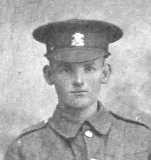
Griffith Ellis Griffiths, Private, 77493, Royal Welsh Fusiliers. Griffith was the son of Griffith Griffiths and Gwen Griffiths (nee Whittaker), of 45, Dovey View, Machynlleth. He was a member of St. Peter’s Church and was a chorister before going to Port Talbot to find work after leaving school. Griffith enlisted into the army at Port Talbot and was drafted to France in the Spring of 1918, joining the 17th Battalion, Royal Welsh Fusiliers, which was holding the line north of Albert along Bouzincourt Ridge, attached to 115 Brigade, 38th (Welsh) Division. The Division had moved here at the end of March 1918, relieving the battered 2nd and 47th Divisions. It held this sector, again carrying out minor operations and trench raids, over the coming months, before taking part in the great offensive of 21 August 1918, and began its advance towards the Hindenburg Line. The 17th RWF had been in support during the initial assault, then on 23 August crossed the Ancre at Albert, relieving the 13th RWF, before continuing the advance on the following day. Over the coming days the Division pressed on, capturing Pozieres, Mametz Wood, Longueval and Delville Wood, then taking Lesboeufs and Sailly-Saillisel before attacking Morval on 1 September. The 17th RWF then took part in an assault east of Sailly-Saillisel upon the village of Mesnil-en-Arrouaise over the next two days. Griffith was killed in action here on 3 September 1918. The 19-year-old is buried in Sailly-Saillisel British Cemetery, France.
Richard Griffiths, Private, 69416, Royal Welsh Fusiliers. Richard was the son of Thomas Griffiths and Mary Griffiths (nee Beedle), of Haulfan, Ffridd Gate, Machynlleth. The family was living at 4, Railway Side, Porth prior to the war, and Richard enlisted there into the Royal Welsh Fusiliers. Upon completing his training, he was posted to Egypt and joined the 24th Battalion, Royal Welsh Fusiliers, which was in Palestine attached to 231 Brigade, 74th (Yeomanry) Division. Richard took part in the Divisions final actions in Palestine before it was transferred to France in May 1918. Upon arrival at Marseilles, the Division entrained for Northern France, and moved to Noyelles, where the Division detrained before moving to Doullens to begin a course of intensive training. On 26 June the 24th Battalion, Royal Welsh Fusiliers became one of three battalions transferred away from the 74th Division, and joined 94 Brigade, 31st Division in the Lynde area, moving to Morbecque. Over the coming weeks the Division remained in the same sector, the 24th RWF spending time repairing roads near Bailleul, but to the south, on 8 August 1918, a combined Australian and Canadian success at Villers-Bretonneux had broken the spirit of the German army, and from 21 August onwards the Allies began to advance. The 31st Division moved to Hill 63 on 5 September and began its advance from there on the following day. By 29 October the Division had reached Veerke, taking over the front line before advancing on Caster, and saw heavy fighting there on 31 October 1918. Richard was killed during the fighting that day. The 27-year-old is buried in Harlebeke New British Cemetery, Belgium. His brother, David, had been killed the previous month.
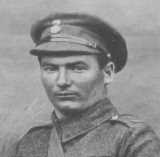
Arthur George Gurney, Corporal, 7870, Welsh Regiment. Arthur was born in Caernarvonshire in 1886, the son of Arthur Gurney. He had served with the Welsh Regiment as a young man and after leaving the army came to live at Machynlleth, where he had gained work as a postman, and he married Catherine Jane Evans on 11 January 1910. The couple then lived at 8, Iorwerth Terrace, Machynlleth, where their only child, Margaretta, was born. Following the outbreak of war, Arthur was mobilised from the Army Reserve and re-joined his old unit, the 2nd Battalion, Welsh Regiment. The battalion moved to France at the outbreak of war, attached to 3 Brigade, 1st Division. The Division had been one of the first to arrive in France, fighting at the Battle of Mons, and taking part in the retreat to the Marne, where the Germans were stopped. They then fought at the Aisne, and at Chivy, before being moved north to Ypres. Here they fought at the First Battle of Ypres, where they again stopped the German Offensive, before wintering in Flanders, in the Richebourg area. The 1st Division took part in its first major action of 1915 here on 9 May 1915, during the Battle of Aubers Ridge, when it attacked alongside the Meerut Division. The attack of the 2nd Welsh was held up by a flooded ditch, which the men forded, before being hit by heavy machine-gun fire, and a large number of casualties were suffered before the survivors withdrew. Arthur was among many men killed during the assault that day. The 29-year-old has no known grave and is commemorated on the Le Touret Memorial, Richebourg-L’avoue, France. Sadly, his wife Catherine died in 1917, leaving their daughter orphaned, while Margaret herself died aged 18.
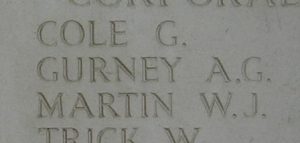
Hugh David Hughes, Private, 31546, Grenadier Guards. Hugh was the son of David and Mary Hughes, of 106, Maengwyn Street, Machynlleth. He enlisted at Welshpool into the Grenadier Guards and was posted to Aldershot to join the 5th (Reserve) Battalion, Grenadier Guards for training. Hugh had only been at Aldershot a few months when he took ill and was sent to Connaught Hospital at Aldershot where he died on 12 July 1918. The remains of the 18-year-old were brought home for burial in Machynlleth Nonconformist Cemetery.
Thomas Hughes, Driver, T/356319, Royal Army Service Corps. Thomas was the son of Thomas and Gwen Hughes, of 9, Iorwerth Street, Machynlleth. He worked as a labourer prior to enlisting into the Army Service Corps on 10 December 1915. Thomas did not serve overseas but remained in Britain for the duration of the war. Thomas had married Annie Jones, of Garden Village, Machynlleth, whilst on leave on 17 November 1916. He was discharged from the army as medically unfit on 30 June 1919 after having been diagnosed as suffering from tuberculosis and returned home to Machynlleth. His health deteriorated over the coming months and Thomas eventually died of tuberculosis on 21 April 1921, aged 44. Nothing further is known of him, as he is not commemorated by the CWGC.
Edward Burton Humphreys, Private, 73279, Royal Welsh Fusiliers. Edward was the son of David and Annie Humphreys, of 34, Pentrerhedyn Street, Machynlleth. He enlisted into the Royal Welsh Fusiliers at Welshpool in February 1917 and was posted to Kinmel Park for training before being posted to Ireland with the 3rd Battalion, Royal Welsh Fusiliers. Edward came home on leave early in October 1917 before being drafted to France, and was posted to the 2nd Battalion, Royal Welsh Fusiliers, which was attached to 19 Brigade, 33rd Division. The Division had moved to the Ypres Salient from positions on the Flanders coast, near Coxyde, just weeks prior to Edward landing in France, to bolster the efforts to take the Passchendaele Ridge. On 30 October 1917 the 2nd RWF took over a section of the support line in the Messines Left sub-sector, spending a very cold and wet line in the trenches. On 3 November the 2nd RWF relieved the 5th Cameronian’s in the front line, to begin a routine tour in the trenches, being relieved four days later and moving back to Bulford Camp to rest. By 19 November the Division had moved slightly north, taking over a section of the line in the Passchendaele sector and on 24 November the 2nd RWF moved into support positions here. The battalion relieved the Cameronian’s in the front line on 27 November, to begin a routine tour in the trenches once more. Edward was killed in action here on 28 November 1917, during only his second spell in the trenches. The 19-year-old is buried in Larch Wood (Railway Cutting) Cemetery, Belgium.
John Richard Humphreys, Private, 27908, Royal Welsh Fusiliers. John, known as Jack, was the son of Edward Humphreys and Mary Humphreys (nee Jones), of Merion House, New Street, Machynlleth. (The family spelt their name as Humphries and Humphreys in various documents). He worked as a shop assistant in London prior to enlisting into the 18th Battalion, Royal Welsh Fusiliers at Holborn on 30 June 1915, and was sent to Kinmel Park for training. Jack was subsequently transferred to the 63rd Training Reserve Battalion, following a reorganisation of the training units, then on 21 September 1917 was transferred to the 3rd Battalion, Royal Welsh Fusiliers. Jack embarked at Southampton on 31 December 1917 and disembarked at Itea, Salonika on 25 January 1918, joining the 11th Battalion, Royal Welsh Fusiliers. The battalion was attached to 67 Brigade, 22nd Division and had been in Salonika since May 1915, fighting a campaign against a combined Austrian and Bulgarian army, which had invaded Serbia before being stopped on the Greek border. Jack saw his first major action when the Allies launched a massive assault, the Second Battle of Doiran, here on 18 September 1918. He was killed in action during the battle that day. The 24-year-old is buried in Doiran Military Cemetery, Greece.
Hugh Richard Jones, Private, 22222, Army Cyclist Corps. Hugh was the son of Richard and Mary Ann Jones, of 7, Rock Terrace, Machynlleth. He worked as a joiner prior to the war. Hugh enlisted into the army at Merthyr and was posted to the 66th Training Reserve Battalion at Kinmel Park for training. He was then transferred to the 67th Divisional Army Cyclist Corps. Hugh took ill during the summer of 1918 and went home on leave, suffering from enteric fever. He died at Machynlleth as a result of fever and pneumonia on 7 July 1918. The 24-year-old was buried in Machynlleth Nonconformist Cemetery.
John Jones. John cannot presently be identified.
John Haydn Jones, Corporal, 23041, Royal Welsh Fusiliers. John was the son of Daniel and Elizabeth Jones, of 13, Windsor Terrace, Machynlleth. He was in business with his father as a tailor and draper prior to the war and was also assistant scoutmaster to the Machynlleth troop of Boy Scouts. John was also an accomplished musician and was the organist at Maengwyn Chapel. He enlisted into the Royal Welsh Fusiliers at Machynlleth in February 1915 and was posted to the 13th Battalion, Royal Welsh Fusiliers. The battalion had been raised at Rhyl by the Denbigh and Flint T.F. Associations, transferring to the Welsh National Executive Committee on 10 October 1914 and joined 128 Brigade, 43rd (Welsh) Division. The battalion trained in North Wales before moving to Winchester in the summer of 1915, where the formation became renumbered 113 Brigade, 38th (Welsh) Division. The Division moved to France on 2 December 1915 and moved to the Nursery Sector near Fleurbaix for trench initiation alongside the Guards Division. On 17 February 1916 the 13th RWF moved from Divisional Reserve at Locon to take over a portion of the line at Givenchy by itself for the first time. John was killed in action here on 18 February 1916, probably whilst part of a patrol which was sent out to attack a German patrol which had been spotted. The 20-year-old is buried in Guards Cemetery, Windy Corner, Cuinchy, France.
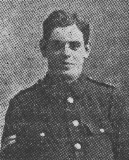
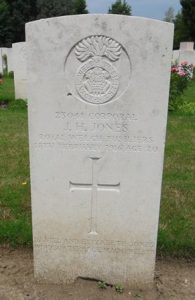
John Rowland Jones, Private, 290255, Royal Welsh Fusiliers. John was the son of John Rowland Jones and Annie Jones, of 23, Doll Street, Machynlleth. He worked as a stone cutter at Newtown prior to enlisting into the 7th Battalion, Royal Welsh Fusiliers at Newtown on 9 August 1914. The battalion was a Territorial unit, which mobilised for war at Newtown in August 1914, as part of North Wales Brigade, Welsh Division and moved to Conway until the end of the month, before moving to Northampton. In December the Division moved to Cambridge and then in May 1915 to Bedford, where the Division was numbered and the formation became 158 Brigade, 53rd (Welsh) Division. On 19 July 1915 the entire Division sailed from Devonport for Imbros and on 9 August 1915 landed at Suvla Bay. The infantry moved off the beaches across the Salt Lake, under shellfire, into the scrub covered Chocolate Hill, but due to a lack of maps and no knowledge of the terrain, many of the units became disorientated, and the situation became chaotic. After the fighting died down, the winter rolled in, and the men first had to endure torrential downpours, which flooded the trenches, before the snow hit, and many men began falling ill in the terrible conditions. The Division was eventually evacuated from Gallipoli in December 1915, moving to Egypt to join the EEF, and helped guard the Suez Canal before taking part in operations to drive the Turks out of the Sinai. The EEF then turned its attention onto driving the Turks out of Palestine, and on 26 March 1917 launched its first offensive against the coastal city of Gaza, which guarded the road to Jerusalem. Initial gains during the day were lost when the assaulting divisions lost touch with each other, and communication broke down when a thick fog cloaked the battlefield. John was killed in action during the assault that day. The 20-year-old is buried in Gaza War Cemetery. He is also commemorated on the Newtown war memorial.
Rowland Jones, Private, 78068, Durham Light Infantry. Rowland was the son of Edward and Margaret Jones, of 61, Maengwyn Street, Machynlleth. He worked as a general labourer prior to the war. Rowland enlisted into the army on 27 March 1916 and had originally served with the 4th (Reserve) Battalion, Welsh Regiment. Upon being drafted to France he was posted to the 12th Battalion, Loyal North Lancashire Regiment, before being transferred to the 2/5th Battalion, Durham Light Infantry, which was attached to 228 Brigade, 28th Division in Salonika. He took ill whilst stationed in Salonika and was sent home by hospital ship, surviving being torpedoed in the Mediterranean in February 1918. Rowland was hospitalised before being discharged from the army as medically unfit on 1 July 1918 and returned home to Machynlleth. Sadly, his health worsened, and he died of disease, probably malaria, at home on 30 December 1919. The 42-year-old was buried in Machynlleth Nonconformist Cemetery.
David Lewis, Acting Bombardier, 187297, Royal Garrison Artillery. David was the son of William Lewis and Sarah Lewis, of Meirion View, Derwenlas. He was educated at the County School and had then gained a post as a teacher at the Council School before leaving to study for his degree at Bangor University in September 1914. He then left Bangor to enlist into the Royal Field Artillery but was then transferred to the Royal Garrison Artillery before being drafted to France in November 1917. David served in France until the Armistice, when he was posted to Germany with the 63rd Brigade HQ, Royal Garrison Artillery, as part of the Army of Occupation. David took ill during the Spring of 1919 and was hospitalised in Bonn, where he died of heart disease on 14 April 1919. The 26-year-old is buried in Cologne Southern Cemetery, Germany.
Edward Lewis, Private, 55299, Royal Welsh Fusiliers. Edward was the son of John Lewis and Catherine Lewis (nee Jones), of Rock Terrace, Machynlleth. He worked in Manchester as a warehouseman and was a talented musician prior to the war. Edward enlisted into the Royal Welsh Fusiliers back home at Machynlleth and was posted to Kinmel Park for training. He was drafted to France in the Winter of 1916-17, joining the 14th Battalion, Royal Welsh Fusiliers, which was in the Canal Bank sector north of Ypres, at Boesinghe. The battalion was attached to 113 Brigade, 38th (Welsh) Division and had taken over this sector of the line in September 1916 following its epic assault on Mametz Wood in July. The infantry battalions of the Division then began carrying out the normal pattern of rotation in the trenches, four days in the front, four in support and four in reserve, whilst also working on trench improvement, digging new trenches, and also carrying out regular patrols and trench raids. On 13 February 1917 the 14th RWF relieved the 13th RWF in the front line to begin a routine tour in the trenches. A large raiding party of 5 officers and 170 men was then organised and on the night of 16-17 February crossed No Man’s Land under the cover of night and raided the enemy lines. Operations such as this often brought swift retaliation in the form of artillery fire being directed onto the front lines, so this spell in the trenches was to prove horrific. Edward was wounded during this tour and was evacuated to the Casualty Clearing Station at Mendinghem where he died of his wounds on 24 February 1917. The 26-year-old is buried in Mendinghem Military Cemetery, Belgium.
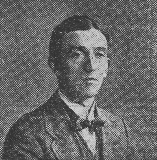
Haydn Lewis, Guardsman, 2172, Welsh Guards. Haydn was the son of Henry and Jane Lewis, of Tower House, Machynlleth. He lived at Aberystwyth prior to the war and enlisted into the Welsh Guards. He had served in France with the 1st Battalion, Welsh Guards for two years before being invalided home wounded and suffering from shell shock. Haydn had been hospitalised at Warrington for several months and was looking to be on the road to recovery when he died on 23 September 1919, aged 23. He is buried in Machynlleth Nonconformist Cemetery.
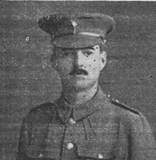
John Watkin Lewis, Private, 9158, South Wales Borderers. John was the son of David Morgan Lewis and Margaret Lewis (nee Charles), of Machynlleth. He enlisted at Carnarvon into the Royal Welsh Fusiliers on 14 April 1903, and served until 1911, when he left the army, and made a home at Frongoch, Dolgellau. He then re-enlisted into the army, joining the 2nd Battalion, South Wales Borderers, and was in Tientsin, China at the outbreak of war. The battalion landed at Lao Shan Bay on 23 September 1914 and took part in the capture of the German port of Tsingtao in conjunction with the Japanese forces. The battalion then embarked at Hong Kong for England on 4 December 1914, and landed at Plymouth on 12 January 1915, moving to Rugby to join 87 Brigade, 29th Division. The Division sailed from Avonmouth for the Mediterranean on 17 March 1915 and moved to Mudros before landing at Gallipoli on 25 April 1915. John fought throughout the Gallipoli campaign with the Division and was evacuated with the Division to Egypt on 11 January 1916. On 15 March 1916 the Division landed at Marseilles and moved to the Somme sector, taking over the line facing Beaumont Hamel. John was taken prisoner during a German trench raid against the South Wales Borderers on 6 April 1916, which caused the experienced battalion some embarrassment. His health had started to suffer in captivity, and he was released by the Germans, before being discharged from the army as medically unfit on 31 August 1917. Upon his return to Wales, he returned to at Frongoch, Dolgellau. He died at Tregaron Sanatorium of tuberculosis on 31 January 1920, aged 34. His remains were buried in St. Peter’s Churchyard, Machynlleth.
Percy Lewis, Private, 4352, Royal Welsh Fusiliers. Percy was the son of John and Jane Lewis, of Milford House, Machynlleth. He resided at Slough prior to the war, and enlisted at London into the army, being posted to the 3/7th Battalion, Royal Welsh Fusiliers. The battalion had formed in June 1915 as reserve units. Percy was on home service when he took ill, and was invalided to the Isolation Hospital, at Chester. He died there on 3 May 1916, aged 34, and is buried at Machynlleth Nonconformist Cemetery.
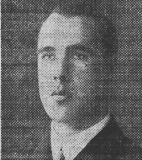
William Lloyd. William cannot presently be identified.
David James William Mathews, Private, 859618, Canadian Infantry. David was born at Llanfair Caereinion on 5 July 1899, the son of Doctor James Snodgrass Mathews and Mary Anne Mathews (nee Williams). By 1891 the family had moved to Bank Place, Machynlleth, where David’s father ran his own medical practise. Following his death in 1911, the family emigrated to Canada, and moved to Belmont, Manitoba. David worked at Belmont as a clerk in a chemist’s store, prior to enlisting into the 179th Overseas Battalion, Canadian Infantry at Winnipeg on 22 January 1916. The battalion embarked at Halifax for Liverpool on 4 October 1916 before entraining for Sandling, in Kent. David embarked for France on 12 November 1916, joining the 43rd Battalion, Canadian Infantry, which was attached to the 9th Infantry Brigade, 3rd Canadian Division, and had just taken part in ferocious fighting during the Battle of the Ancre Heights, where the Canadian Corps captured Regina Trench. The Canadian Corps then moved north to positions facing Vimy Ridge, north of Arras, and on 9 April 1917 launched their impressive assault on the Vimy Ridge, gaining their objectives before advancing to the Arras-Lens Road. In October 1917 the Canadians moved north into the Ypres Salient. On 21 October the 43rd Battalion moved into the support trenches east of Ypres and on 23 October relieved a New Zealand unit in the front-line facing Passchendaele Ridge. At dawn on 26 October 1917 the 43rd Battalion assembled on the bank of the Ravelbeek and assaulted the Bellevue Ridge. Lieutenant Shankland of the battalion gained the award of the Victoria Cross for the action which followed, but the battalion suffered over 300 casualties during the day. David was posted as missing during the attack but was later deemed to have been killed in action. The 28-year-old has no known grave and is commemorated on the Ypres (Menin Gate) Memorial, Belgium.
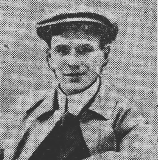
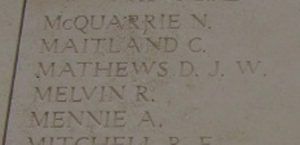
Edward Owen, Sergeant, 39, Royal Welsh Fusiliers. Edward was the son of John Owen and Margaret Owen (nee Edwards), of Maengwyn Street, Machynlleth. He worked as a postman and in 1908 married Mary Ellen Gibson. The couple set up home at 1, Iorwerth terrace, Machynlleth, where their three children were born. Edward was a long serving Territorial, having served with the 7th Battalion, Royal Welsh Fusiliers for many years prior to the war. The battalion was a Territorial unit, which mobilised for war at Newtown in August 1914, as part of North Wales Brigade, Welsh Division and moved to Conway until the end of the month, before moving to Northampton. In December the Division moved to Cambridge and then in May 1915 to Bedford, where the Division was numbered and the formation became 158 Brigade, 53rd (Welsh) Division. On 19 July 1915 the entire Division sailed from Devonport for Imbros and on 9 August 1915 landed at Suvla Bay. The infantry moved off the beaches across the Salt Lake, under shellfire, into the scrub covered Chocolate Hill, but due to a lack of maps and no knowledge of the terrain, many of the units became disorientated, and the situation became chaotic. Edward was killed in action on the following day, 10 August 1915. The 40-year-old has no known grave and is commemorated on the Helles Memorial, Gallipoli.
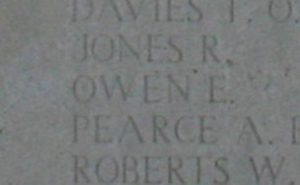
Thomas Edgar Owen, Lance Sergeant, 290052, Royal Welsh Fusiliers. Thomas was the son of John Owen and Ann Owen, of Tanrallt Street, Machynlleth. Edgar worked an engine cleaner for the Cambrian Railways prior to the war. He was a long serving territorial soldier, having enlisted into the 7th Battalion, Royal Welsh Fusiliers at Machynlleth on 5 May 1910 and had attended the annual TA camps at Bow Street, Carnarvon and Rhyl prior to the war. The battalion was a Territorial unit, which mobilised for war at Newtown in August 1914, as part of North Wales Brigade, Welsh Division and moved to Conway until the end of the month, before moving to Northampton. In December the Division moved to Cambridge and then in May 1915 to Bedford, where the Division was numbered and the formation became 158 Brigade, 53rd (Welsh) Division. On 19 July 1915 the entire Division sailed from Devonport for Imbros and on 9 August 1915 landed at Suvla Bay. The infantry moved off the beaches across the Salt Lake, under shellfire, into the scrub covered Chocolate Hill, but due to a lack of maps and no knowledge of the terrain, many of the units became disorientated, and the situation became chaotic. Thomas was captured within days of the landings and taken prisoner by the Turks before being sent to a prisoner of war camp at Angora. He died of chronic enteritis whilst in captivity there on 28 November 1916. The 26-year-old has no known grave, but is commemorated on Angora Memorial 126, in Baghdad (North Gate) War Cemetery, Iraq.
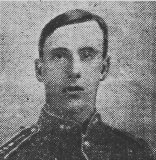
George Griffiths Parry, Private, 55996, Royal Welsh Fusiliers. George was the son of John and Elizabeth Parry, of Bryn Hyfryd, Cemmaes. He enlisted into the 7th Battalion, Royal Welsh Fusiliers at Machynlleth and in the spring of 1917 was drafted to France, being posted to the 15th Battalion, Royal Welsh Fusiliers, which was at Ypres attached to 113 Brigade, 38th (Welsh) Division. The Division had moved to Ypres following heavy losses at Mametz Wood in July 1916 and had taken over the Canal Bank sector at Boesinghe, north of Ypres. Over the coming months the Divisional troops had worked hard, improving the defences and constructing deep dugouts and saps, in preparation to take part in the opening of the Third Battle of Ypres on 31 July 1917. The 15th RWF had spent much of July training at Flechin, moving back to Proven, just behind the lines, on 18 July, and on 23 July moved back into positions in the front line. On 27 July one Company of the 15th RWF was sent out to investigate reports from an RFC aircraft that the Germans had withdrawn, but suffered heavy casualties upon reaching the German lines, as the reports had been incorrect. Nevertheless, the battalion remained in the line and continued to prepare for the launching of the great offensive, the Division being tasked with the capture of Pilckem Ridge. At dawn on 31 July 1917 the Division went over the top, and the 15th RWF, for their part, captured its objective of Iron Cross, before consolidating its gains. George was killed in action during the days fighting. The 28-year-old has no known grave and is commemorated on the Ypres (Menin Gate) Memorial, Belgium.
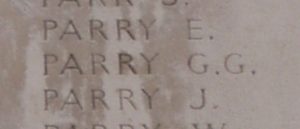
William Pritchard, Lance Corporal, 290827, Royal Welsh Fusiliers. William was born at Newtown in 1897, the son of William Pritchard and Marion Pritchard (nee Owen). By 1901 the family had moved to Machynlleth, and William’s father worked at the Sion Hotel. William himself worked as a grocer’s assistant prior to enlisting into the 7th Battalion, Royal Welsh Fusiliers at Newtown on 11 November 1914. The battalion was a Territorial unit, which mobilised for war at Newtown in August 1914, as part of North Wales Brigade, Welsh Division and moved to Conway until the end of the month, before moving to Northampton. In December the Division moved to Cambridge and then in May 1915 to Bedford, where the Division was numbered and the formation became 158 Brigade, 53rd (Welsh) Division. On 19 July 1915 the entire Division sailed from Devonport for Imbros and on 9 August 1915 landed at Suvla Bay. The infantry moved off the beaches across the Salt Lake, under shellfire, into the scrub covered Chocolate Hill, but due to a lack of maps and no knowledge of the terrain, many of the units became disorientated, and the situation became chaotic. The Division was eventually evacuated from Gallipoli in December 1915, moving to Egypt to join the EEF, and helped guard the Suez Canal before taking part in operations to drive the Turks out of the Sinai. The EEF then turned its attention onto driving the Turks out of Palestine, and on 26 March 1917 launched its first offensive against the coastal city of Gaza, which guarded the road to Jerusalem. Initial gains during the day were lost when the assaulting divisions lost touch with each other, and communication broke down when a thick fog cloaked the battlefield. A second attempt to force Gaza was launched on 17 April, which also failed, and the EEF suffered a change in leadership, with Sir Edmund Allenby assuming command, before being re-organised, and a third offensive was launched against a wider front from Beersheba to Gaza on 31 October 1917. This time the Turkish defences were breached, and the road to Jerusalem now lay open and the EEF began to advance north. On 6 November 1917, 158 Brigade launched an attack on the Khuweilfeh Heights. William was killed in action during the assault that day. The 20-year-old is buried in Beersheba War Cemetery, Israel.
Maldwyn Richards, Corporal, 320175, Welsh Regiment. Maldwyn was born in 1881, the son of Evan and Ellen Richards, of 11, Windsor Terrace, Machynlleth. He had served in the army for twelve years, seeing action in South Africa during the Anglo-Boer War and then in India, prior to leaving the colours and becoming a postman at Aberystwyth. At the outbreak of war Maldwyn was mobilised from the Army Reserve, joining the Pembroke Yeomanry at Lampeter. During March 1916 the 1/1st Pembroke Yeomanry moved to Egypt, where it merged with the Welsh Border Mounted Brigade and formed the 4th Dismounted Brigade. On 2 February 1917 it merged with the 1/1st Glamorgan Yeomanry to form the 24th Battalion, Welsh Regiment, and became attached to 231 Brigade, 74th (Yeomanry) Division. The Division had formed in Egypt in January 1917 and had fought through the Palestinian Campaign, at the Battles of Gaza and the Battle and capture of Jerusalem. Maldwyn was killed during the march to Jerusalem on 31 October 1917, aged 36. He has no known grave and is commemorated on the Jerusalem Memorial, Israel. Maldwyn is also commemorated on the Aberystwyth Post Office war memorial.
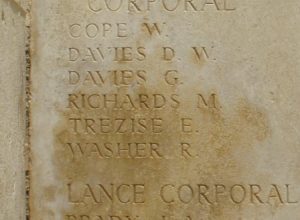
John Ellis Roberts, Private, 34229, South Lancashire Regiment. John was the son of Richard Roberts and Jane Roberts (nee Davies), of 2, Glasfryn, Penrallt Street, Machynlleth. He worked as a labourer prior to the war. John enlisted into the army at Swansea and was initially posted to the Welsh Regiment for training at Kinmel Park. Upon being drafted to France early in 1916 he was posted to the 8th Battalion, South Lancashire Regiment, which was at Écoivres, in the Neuville St. Vaast sector, attached to 75 Brigade, 25th Division. During June 1916 the Division was relieved and began the long march south to the Somme, reaching Toutencourt by 28 June. The Division then took over trenches south of Thiepval and launched its first assault of the Somme offensive here on 3 July, the third day of the terrible battle. The Division had a brief rest before moving to the Tara and Usna Line four days later, launching an assault to the south of Ovillers before consolidating its gains and remained in the line here until 16 June when the 8th South Lancs carried out a bombing attack. The Division was relieved the following day and enjoyed a rest behind the battle zone before moving to Auchonvillers and taking over the line near Beaumont Hamel. The Division attacked the Leipzig Salient at the end of August, capturing and consolidating the Leipzig Redoubt before having another rest. By the end of the month the Division was back in the line at Hessian Trench and on 21 October 1916 took part in the fighting for Regina Trench. John was killed in action during the fighting for Regina Trench that day. The 27-year-old has no known grave and is commemorated on the Thiepval Memorial, France.
Lloyd Wynn Roberts, Sergeant, 290266, Royal Welsh Fusiliers. Lloyd was the son of Lloyd Roberts and Ellen Roberts (nee Edwards), of 26, Brickfield Street, Machynlleth. He married Ellen Holt on 25 October 1900 and the couple resided at Hafodygarreg Cottages, Machynlleth. Lloyd had worked as a water bailiff and then as a timber haulier prior to the war. He enlisted into the 7th Battalion, Royal Welsh Fusiliers at Machynlleth on 11 August 1914. The battalion was a Territorial unit, which mobilised for war at Newtown in August 1914, as part of North Wales Brigade, Welsh Division and moved to Conway until the end of the month, before moving to Northampton. In December the Division moved to Cambridge and then in May 1915 to Bedford, where the Division was numbered and the formation became 158 Brigade, 53rd (Welsh) Division. On 19 July 1915 the entire Division sailed from Devonport for Imbros and on 9 August 1915 landed at Suvla Bay. The infantry moved off the beaches across the Salt Lake, under shellfire, into the scrub covered Chocolate Hill, but due to a lack of maps and no knowledge of the terrain, many of the units became disorientated, and the situation became chaotic. The Division was eventually evacuated from Gallipoli in December 1915, moving to Egypt to join the EEF, and helped guard the Suez Canal before taking part in operations to drive the Turks out of the Sinai. The EEF then turned its attention onto driving the Turks out of Palestine, and on 26 March 1917 launched its first offensive against the coastal city of Gaza, which guarded the road to Jerusalem. Initial gains during the day were lost when the assaulting divisions lost touch with each other, and communication broke down when a thick fog cloaked the battlefield. Lloyd was killed in action during the assault that day. The 34-year-old is buried in Gaza War Cemetery.
Roderick Roberts, Private, 27355, South Wales Borderers. Roderick was the son of John Roberts and Jane Roberts (nee Hughes), of 1, Vale View, Machynlleth. He worked for W. H. Smith & Son at Aberystwyth and Machynlleth prior to the war. Roderick enlisted into the South Wales Borderers on 2 December 1915 and served overseas for much of the war. His health had broken down by the time of the Armistice and he was hospitalised at Newport for several months before being discharged as medically unfit on 20 February 1919. Roderick returned home where he died of tuberculosis on 16 October 1919, aged 23. Roderick was buried at Machynlleth Nonconformist Cemetery. He was originally not commemorated as a war casualty by the CWGC, but his case was forwarded to the CWGC as a result of my research, and he was accepted for commemoration by them on Thursday 27 August 2020.
William Baxter Roberts, Driver, 701699, Royal Field Artillery. William was born at Machynlleth in 1884, the son of Elizabeth Ellen Roberts, of Leicester House. He worked as a boot and shoe salesman and lived at Oakford, North Road, Cardigan prior to the war. William married Mary Lavinia Sharpe, a domestic servant, of Green Meadow, St. Dogmaels prior to enlisting at Cardigan into the army. He was posted to the Royal Field Artillery, joining B Battery, 330th Brigade, which was attached to the 66th (East Lancs) Division. The Division concentrated on the Western Front by 16 March 1917 and moved to the Flanders Coast near Bray Dunes to prepare for a possible offensive along the coast to free the ports of Nieuwpoort and Oostende. William’s battery spent much of the coming months at Le Preol, but on 20 July moved and took up gun positions at Nieuwpoort Bains, some 1,000 yards west of the Yser. The battery was then engaged in counter-battery work over the coming weeks. William was killed in action here by German artillery fire on 31 July 1917. He was 33 years old, and is buried at Coxyde Military Cemetery, Belgium. William is also commemorated on the Cardigan war memorial.
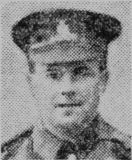
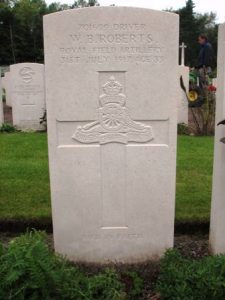
Henry John Rowlands, Private, 301963, Tank Corps. Henry was the son of Joseph Rowlands and Elizabeth Rowlands (nee Pugh), of 40, Railway Terrace, Cwmpark. Following the death of his mother, Henry was sent to live with his grandparents, Richard Rowlands and Ann Rowlands, of 35, Pentrehedyn Street, Machynlleth. He worked for the Cambrian Railways as a platelayer prior to the war. Henry enlisted at Cwmpark into the 10th Battalion, Welsh Regiment soon after the outbreak of war. The battalion was raised in the Rhondda Valley, comprised mainly of miners, but was soon oversubscribed, so Henry was among some 200 men transferred to the 15th Battalion, Welsh Regiment, which was the Carmarthenshire Battalion. The battalion trained in North Wales before moving to Winchester in the summer of 1915, where the formation became renumbered 114 Brigade, 38th (Welsh) Division. The Division moved to France on 2 December 1915 and moved to the Nursery Sector near Fleurbaix for trench initiation alongside the Guards Division. The Division then held a sector of the line near Cuinchy before marching south to the Somme sector in June 1916 to take part in the assault on Mametz Wood. The first attack on the wood was launched on a two-battalion front on 7 July, but failed, and the Divisional Commander, Sir Ivor Philipps, was replaced before the Division attacked again on a two Brigade front on 10 July 1916. After two days of ferocious hand-to-hand fighting, the wood was cleared up to its northern edge, before the battered Division was relieved. It then took over a section of the front at Hébuterne before moving to the Ypres Salient and taking over the Canal Bank sector at Boesinghe. Henry must have been wounded at some time as he transferred to the South Lancashire Regiment, before transferring again to the Tank Corps and was posted to the 13th Battalion, Tank Corps. The battalion was formed in August 1917 due to the rapid expansion of the Tank Corps and arrived in France in January 1918, moving initially to Bray to complete its training before moving to the Somme. The Germans launched a massive offensive along the Lys Valley on 9 April, so the 13th Battalion then transferred to the Ypres Salient, by road, on 13 April and the men were, for the time being, used to reinforce the depleted 34th Division at Mont Noir. Henry was killed in action in the front line here on 25 April 1918. The 22-year-old has no known grave and is commemorated on the Tyne Cot Memorial, Belgium.
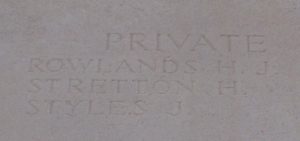
David Thomas, Private, 61307, Royal Welsh Fusiliers. David was the son of Griffith and Ellen Thomas, of 25, Wesley Terrace, Machynlleth. He worked as an engine cleaner for the Cambrian Railways prior to enlisting into the Royal Welsh Fusiliers at Machynlleth and was posted to Kinmel Park for training. David was drafted to France in the Spring of 1917, joining the 15th Battalion, Royal Welsh Fusiliers. The battalion was holding the Canal Bank sector at Boesinghe, north of Ypres, and had been there since moving from the Somme in August 1916, following its epic assault on Mametz Wood. After taking over the Canal Bank sector, the infantry battalions of the Division began carrying out the normal pattern of rotation in the trenches, four days in the front, four in support and four in reserve, whilst also working on trench improvement, digging new trenches, and also carrying out regular patrols and trench raids. Most of the work carried out by the Division over the coming months was in preparation for the forthcoming Passchendaele offensive, in which the 38th Division was to play a vital part, with orders to assault and take the Pilckem Ridge on 31 July 1917. In the meantime, its battalions carried out their work, intermixed with spells out of the line training on a scale replica of the battlefield. The 15th RWF was holding the line in the days running up to the offensive, when on 27 July 1917 intelligence was received from the Royal Flying Corps that the Germans facing them had withdrawn. It was decided to send out A Company of the 15th RWF to investigate the intelligence which, unfortunately, proved to be incorrect, and heavy casualties were suffered as A Company advanced towards the German trenches, which were fully manned. David was killed in action during the patrol. The 21-year-old has no known grave and is commemorated on the Ypres (Menin Gate) Memorial, Belgium.
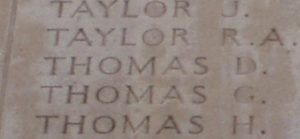
Richard Henry Thomas, Private, A22541, Canadian Infantry. Richard was born on 15 March 1883, the son of David and Jane Thomas, of Derwenlas, Machynlleth. He worked as an ironmonger at Machynlleth prior to emigrating to Canada at some time prior to the war. Richard then found work as a bank manager and lived with his wife, Laura May Thomas at 123, Kennedy Street, Winnipeg. He enlisted into the 44th Overseas Battalion, Canadian Infantry at Winnipeg on 1 January 1915. Richard embarked for England at Montreal aboard the SS Grampian on 1 June 1915, as part of the 1st reinforcement draft for the 8th Battalion, Canadian Infantry, then after a brief period in England was taken on strength by the 8th Battalion at Ploegsteert on 22 July 1915, as part of a draft of 240 men. The battalion was attached to the 2nd Canadian Brigade, 1st Canadian Division and had just suffered heavy fighting during the First Battle of Ypres and in the Second Action of Givenchy, where the 1st Canadian Division attacked the Dorchester position at Givenchy on 15 June, suffering heavy casualties. The Canadians saw no more major battles over the coming months and in April 1916 Richard was granted seven days leave and returned home to Machynlleth to see his family, before returning to France. Upon his return to France, he was caught up in one of the Canadians most famous actions of the war. On 2 June 1916 the Hill 62 area came under attack by the Germans in an action known as the Battle of Mount Sorrel. The fighting was ferocious and although the Germans initially broke the Canadian line, the situation was restored after days of terrible fighting. Richard was evacuated to No 1 Divisional Rest Station on 14 June 1916, suffering with shellshock, re-joining the 8th Battalion on 2 August, in time for its move south to the Somme, with the remainder of the Canadian Corps. By 5 September the 8th Battalion had moved to reserve positions at Tara Hill, near Ovillers, before moving forward to the recently captured ruins of Pozieres, before taking over the front line near Mouquet Farm. Richard was killed in action here on 8 September 1916, during a terrible day which saw a German counterattack followed by bouts of heavy artillery fire. The 33-year-old has no known grave and is commemorated on the Vimy Memorial, France.
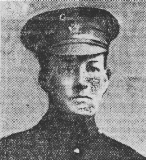
Stanley West, Private, 18358, Royal Welsh Fusiliers. Stanley was born on 19 May 1880, the son of Arthur and Hannah West, of Aberystwyth. On 10 April 1911 he married Margaret Ellen Williams and the couple set up home at 1, Lledfam Place, Machynlleth. Stanley enlisted at Machynlleth into the 8th Battalion, Royal Welsh Fusiliers, which was attached to 40 Brigade, 13th (Western) Division. Towards the end of February, the entire Division concentrated at Blackdown in Hampshire, and on 13 June 1915 sailed for Alexandria, moving to Mudros before being landed at Cape Helles, Gallipoli from 6 July 1915, relieving the 29th Division. The Division was evacuated from Suvla on 19 December 1915, and after a rest moved to the Helles bridgehead. On 8 January 1916, the Division was evacuated from Helles, and by 31 January was concentrated at Port Said, where they held forward posts in the Suez Canal defences. On 12 February 1916 the Division began to move to Mesopotamia, to strengthen the force being assembled for the relief of the besieged garrison at Kut al Amara. By 27 March, the Division had assembled near Sheikh Saad and came under orders of the Tigris Corps, and then took part in the attempts to relieve Kut. Stanley died of fever during the epic trek through the desert, on 1 July 1916. He was 36 years old, and is buried in Amara War Cemetery, Iraq. Stanley is not commemorated on the Machynlleth war memorial, but at his native Aberystwyth.
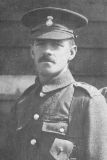
David Rowland Williams, Private, 2414, Welsh Guards. David was the son of Humphrey Jones Williams and Catherine Williams (nee Jones), of Chapel Terrace, Machynlleth. He worked as a butcher’s assistant prior to the war and was a long serving Territorial Army soldier, having enlisted into the 7th Battalion, Royal Welsh Fusiliers at Machynlleth on 20 November 1910. David attended every annual TA summer camp over the coming years, at Lamphey, Carnarvon, Rhyl and at Aberystwyth. The battalion was a Territorial unit, which mobilised for war at Newtown in August 1914, as part of North Wales Brigade, Welsh Division and moved to Conway until the end of the month, before moving to Northampton. In December the Division moved to Cambridge and then in May 1915 to Bedford, where the Division was numbered and the formation became 158 Brigade, 53rd (Welsh) Division. On 19 July 1915 the entire Division sailed from Devonport for Imbros and on 9 August 1915 landed at Suvla Bay. The infantry moved off the beaches across the Salt Lake, under shellfire, into the scrub covered Chocolate Hill, but due to a lack of maps and no knowledge of the terrain, many of the units became disorientated, and the situation became chaotic. David survived the landings and was detached for duty with the 21st General Hospital in Egypt. On 17 October 1915 his period of service lapsed, and he returned home as ‘Time Expired’, having fulfilled his obligatory service period. David then re-enlisted into the newly Formed Welsh Guards and was drafted to France early in 1916, joining the 1st Battalion, Welsh Guards which was attached to the 3rd Guards Brigade, Guards Division. The Division had seen its first major action during the Battle of Loos, which began on 25 September 1915, and had suffered heavy casualties at Hill 70, before also taking part in the Action of the Hohenzollern Redoubt. The Division had a brief rest in the Calais area, before moving to the Ypres Salient, and held the line at Potijze for several months. At the end of July 1916, the Division withdrew from Ypres and moved to the Somme, before holding the line north of the Ancre for a short period. By 25 August the Guards Division had moved slightly south, and had marched passed Corbie, to Mericourt-L’Abbe. By 9 September the Guards had passed Ginchy, and moved into positions at Guillemont, prior to taking part in the Battle of Flers-Courcelette, the first-time tanks were ever used in action. David was badly wounded at Flers and was evacuated to a hospital at Corbie where he died of his wounds on 12 September 1916. The 23-year-old was buried in La Neuville British Cemetery, Corbie, France.
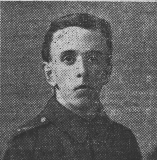
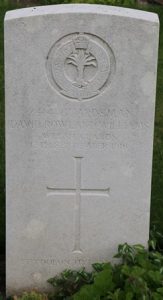
John Isaac Williams, Private, 202121, King’s Shropshire Light Infantry. John was the son of Isaac Williams and his wife Catherine Williams (nee Jones), of Graigfach, Machynlleth. He married Mary Lydia Mulberry at Machynlleth in 1905 and the couple initially lived in Machynlleth, where their first two children were born, before moving to Newport, Shropshire, where John had gained a job as a postman, and their third child was born. John enlisted at Newport into the King’s Shropshire Light Infantry and was drafted to France in the Summer of 1917, joining the 1st Battalion, King’s Shropshire Light Infantry. The battalion had been in France since September 1914 attached to 16 Brigade, 6th Division and had seen heavy fighting during the Battle of Arras in April 1917, during the Battle for Hill 70. The Division remained in the Hulluch sector over the summer, before moving out of the line in November to train for the forthcoming Cambrai offensive. The Battle of Cambrai opened on 20 November 1917, with the Allies making great gains in the German lines and was the largest tank action of the war thus far. The 6th Division had moved to Dessart Wood by 16 November in order to attack the section of Hindenburg Line running from Beaucamps to Villers-Plouich and on 20 November managed to capture all its objectives, smashing through the Hindenburg Line and advancing to Marcoing. The 1st KSLI was relieved from the front line on 27 November and moved into Divisional Reserve on the Hindenburg Support Line. The Germans launched a massive counterattack on 30 November 1917 and the 1st KSLI was ordered forwards to take up positions some 1,500 yards north of Gouzeaucourt. The battalion then became caught up in terrible fighting near Quentin Ridge. John was killed in action here that day. The 36-year-old is buried in Sunken Road Cemetery, Villers-Plouich, France.
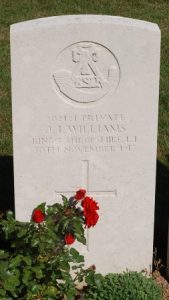
John Richard Williams, Private, 55555, The Loyal North Lancashire Regiment. John was the son of James and Laura Williams, of 5, Bank Street, Machynlleth. He worked as a gardener prior to enlisting into the army at Wrexham on 2 August 1916 and was categorised at Grade C, unfit for overseas service, so was posted to the 2/7th (Cyclists) Battalion, Welsh Regiment, which was at Holt. The battalion moved to Fakenham early in 1917 and by mid-1918 was at Melton Constable. Despite being medically downgraded, losses on the Western Front had been so heavy during March and April 1918 that medical standards were lowered, so on 14 June 1918 John was compulsorily transferred to the 15th Battalion, Loyal North Lancashire Regiment, which was the Pioneer Battalion to the 14th (Light) Division and embarked for France with the battalion on 5 July 1918. The Division had been rebuilding in England following terrible losses in May 1918 and upon its return to France joined the Second Army in the Ypres Salient. By the middle of August, the 15th Loyal’s had reached Proven, moving to a camp near Vlamertinghe before beginning work erecting shelters in the Vlamertinghe Defensive Line. By now the Allies had launched a general offensive along the southern sectors of the Western Front on 21 August 1918 and had begun driving towards the Hindenburg Line. The Ypres Salient remained relatively peaceful during the first weeks of the offensive, then began to prepare to launch an offensive in Flanders. John was wounded during the build up to the offensive, whilst working near Dirty Bucket Camp. He was evacuated to a Casualty Clearing Station at Hagle Dump where he died of his wounds on 13 September 1918. The 21-year-old is buried in Hagle Dump Cemetery, Belgium.
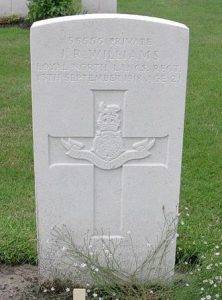
William Louis Williams, Sergeant, 290125, Royal Welsh Fusiliers. William was the son of William J. Williams and Elizabeth Williams, of 27, Doll Street, Machynlleth. He married Eleanor Harding at Machynlleth early in 1911 and the couple set up home at 10, Dovey View, Machynlleth, where their four children were born. William enlisted into the 7th Battalion, Royal Welsh Fusiliers at Machynlleth on 13 September 1912 and over the coming years attended the annual TA summer camps at Rhyl and Aberystwyth. The battalion was a Territorial unit, which mobilised for war at Newtown in August 1914, as part of North Wales Brigade, Welsh Division and moved to Conway until the end of the month, before moving to Northampton. In December the Division moved to Cambridge and then in May 1915 to Bedford, where the Division was numbered and the formation became 158 Brigade, 53rd (Welsh) Division. On 19 July 1915 the entire Division sailed from Devonport for Imbros and on 9 August 1915 landed at Suvla Bay. The infantry moved off the beaches across the Salt Lake, under shellfire, into the scrub covered Chocolate Hill, but due to a lack of maps and no knowledge of the terrain, many of the units became disorientated, and the situation became chaotic. After the fighting died down, the winter rolled in, and the men first had to endure torrential downpours, which flooded the trenches, before the snow hit, and many men began falling ill in the terrible conditions. William was invalided home in December 1915 and took many months to recover his health. Upon recovery, William embarked at Southampton on 20 May 1917, joining the 5th Infantry Base Depot at Rouen, then on 12 June 1917 he was posted to the 15th Battalion, Royal Welsh Fusiliers, which was holding the Canal Bank sector at Boesinghe, north of Ypres, attached to 115 Brigade, 38th (Welsh) Division. The Division had been there since moving from the Somme in August 1916, following its epic assault on Mametz Wood. After taking over the Canal Bank sector, the infantry battalions of the Division began carrying out the normal pattern of rotation in the trenches, four days in the front, four in support and four in reserve, whilst also working on trench improvement, digging new trenches, and also carrying out regular patrols and trench raids. Most of the work carried out by the Division over the coming months was in preparation for the forthcoming Passchendaele offensive, in which the 38th Division was to play a vital part, with orders to assault and take the Pilckem Ridge on 31 July 1917. In the meantime, its battalions carried out their work, intermixed with spells out of the line training on a scale replica of the battlefield. The 15th RWF was holding the line in the days running up to the offensive, when on 27 July 1917 intelligence was received from the Royal Flying Corps that the Germans facing them had withdrawn. It was decided to send out A Company of the 15th RWF to investigate the intelligence which, unfortunately, proved to be incorrect, and heavy casualties were suffered as A Company advanced towards the German trenches, which were fully manned. William was one of two Machynlleth men killed with the 15th RWF during the day. The 28-year-old is buried in Bard Cottage Cemetery, Belgium.
World War Two, 1939-1945
John Leonard Evans, Private, 13002056, Pioneer Corps. John was born in Montgomeryshire in 1903. He was a regular soldier, serving with the Royal Welch Fusiliers, and embarked for France with the BEF, being attached to the 50th Company, Auxiliary Military Pioneer Regiment, Pioneer Corps, which had been formed from Army Reservists. Following the launching of the German Blitzkrieg, John’s unit was pressed into service as infantry, before withdrawing to the French coast for evacuation. The thousands of troops who had made it to Dunkirk had already been evacuated by 6 June, whilst more had been evacuated from Boulogne, Calais and Le Havre by 25 May. More Allied troops had managed to reach ports in other parts of France, stretching from Cherbourg down to Bayonne, so the British organised Operation Aerial, to evacuate Allied forces and civilians from western France. Stanley had managed to reach St. Nazaire with most of his company. On 17 June 1940 the requisitioned RMS Lancastria steamed into the Loire Estuary and anchored in the Charpentier Sounds. By the afternoon Lancastria had taken aboard a huge number of evacuees, far greater than she was built to carry, with estimates running from 4,000 to 9,000 people. The Germans had already begun attacking shipping in the area, and at 15.50 Lancastria was attacked by Junkers-88 bombers and sank in less than 20 minutes. An estimated 6,500 people drowned in the sinking of Lancastria that day. John was 37 years old when he died as a result of the sinking of the Lancastria that day. His body was later recovered from the sea, and he was buried in Pornic War Cemetery, France.
Richard Frederick Grove, Sergeant, 1581242, Royal Air Force Volunteer Reserve. Richard was the son of Frederick George Grove and Eliza Ann Grove (nee Ward), of Machynlleth. He enlisted into the Royal Air Force Volunteer Reserve soon after the outbreak of war and after training as an Air Gunner, was posted to 75 (New Zealand) Squadron, RAF. The squadron was based at RAF Mepal and was a heavy bomber squadron, equipped with the Short Stirling. On the evening of 30 August 1943, Richard took off from Mepal aboard Short Stirling III, Serial EH938, piloted by Flight Sergeant Victor Parkin. The aircraft joined a large number of 660 other bombers as part of a force sent to bomb strategic targets in Monchengladbach and Rheydt. Both targets were successfully hit and badly damaged, but Richard’s aircraft had been damaged and crashed into the ground near Lommel, Belgium, killing all bar one of her crew who managed to bale out and evade capture. Richard was 22 years old when he was killed in the crash that night and is buried in Heverlee War Cemetery, Belgium. Richard is not commemorated on the Machynlleth war memorial.
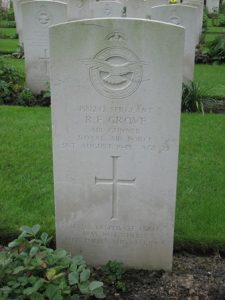
William Walter Selby Grubb, Fusilier, 3125936, Royal Scots Fusiliers. William was born in London in 1905. He married Phyllis Mary Jones, of Machynlleth, in London in 1934. William was a regular soldier, who served with the 1st Battalion, Royal Scots Fusiliers. By 1939 Phyllis was lodging at Blaentafolog, Mallwyd with their infant son. The 1st Battalion spent the whole war as part of the 29th Independent Infantry Brigade Group, which had been formed on 14 July 1940. The unit trained in England until the summer of 1941, when it was posted overseas to the Far East. Just prior to the posting, William was home on leave at Machynlleth with his family when he died on 8 June 1941, aged 36. His infant son, William, appears to have died at the same time, aged just three years. William is buried in Machynlleth Nonconformist Cemetery. He is not commemorated on the Machynlleth war memorial.
Neil Haighton, Able Seaman, P/JX 152380, Royal Navy. Neil was born at Nelson, Lancashire on 12 May 1921, the son of Alan Haighton and Doris Haighton (nee Folley). The family later resided at Machynlleth. Neil enlisted into the Royal Navy and was posted aboard the Hunt-class destroyer, HMS Blean. The destroyer had been launched on 15 January 1942 and commissioned in August 1942, before moving to Scapa Flow. She then moved to the Thames and escorted a convoy to Gibraltar in October 1942. Blean then joined the 58th Destroyer Division, which was escorting the Operation Torch convoys. On 11 December 1942, Blean was escorting convoy MKF-4 off the Algerian coast, when she was torpedoed and sunk by the German submarine U-443, going down quickly with the loss of 89 men. Nel was 21 years old when he died during her sinking. He is commemorated on the Portsmouth Naval Memorial, Hampshire. Neil is not commemorated on the Machynlleth war memorial.
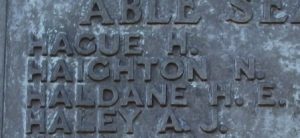
Fred Holmes, Private, 4688077, King’s Own Yorkshire Light Infantry. Fred was born on 14 March 1909, the son of Fred and Ethel Holmes, of Eaton Road, Great Ayton, Yorkshire. He was a regular soldier prior to the war and served with the 1st Battalion, King’s Own Yorkshire Light Infantry, which was attached to the 15th Infantry Brigade, 5th Infantry Division. The Division embarked for France with the BEF in 1939 and spent the winter on the Maginot Line, before being withdrawn from France in April 1940, returning to Scotland. Fred married Alice Mary Margaret Evans, of Machynlleth, whilst on leave after the evacuation, but soon afterwards re-joined his battalion in time for the 5th Division to move to Aandelsnes, Norway where they saw service as part of Sickleforce in the Norwegian Campaign. Fred’s battalion then advanced some 100 miles, before being forced to withdraw following the German invasion of Norway. Fred was taken prisoner in Norway and was sent to a German POW camp in Giessen. Fred died in captivity there on 6 October 1941, aged 32. He was originally buried in Giessen Cemetery, but all the war graves there were exhumed in May 1947 and re-interred in Hanover War Cemetery, Germany. Fred is not commemorated on the Machynlleth war memorial.
Lewis Holt, Private, 10630952, Army Catering Corps. Lewis was born at Pontypridd on 23 September 1917, the son of Ellis and Mary Ann Holt (nee O’Hara). His father was from Machynlleth but had worked in South Wales for several years prior to marrying his mother, who worked as a servant at the Wynnstay in Machynlleth. The family then moved home after Lewis’ birth and resided at 4, Maesglas, Machynlleth. Lewis then worked in the town as a baker before enlisting into the army after the outbreak of war and joined the Army Catering Corps. He was sent to the Far East and took part in the Burma campaign. Lewis was killed at Akyab in Burma on 29 March 1943. The 25-year-old was originally buried in Akyab War Cemetery, but in 1952 all the war graves in the cemetery were exhumed and re-interred in Taukkyan War Cemetery, Myanmar. His cousin, William Ivor Holt, also fell during the war.
William Ivor Holt, Signalman, 14527324, Royal Corps of Signals. William was the son of John Owen Holt and Catherine Mary Holt (nee Jones), of Machynlleth. He married Nora Helen Davies, a waitress at the Belle Vue Hotel, Aberystwyth in 1942 and the couple set up home at Machynlleth. William enlisted into the army and was posted to the 17th Lines of Communications Signals, Royal Corps of Signals, together with his friend, James Latham. The role of his unit was to operate signals equipment and also to maintain telephone lines and other communications infrastructure. William embarked for Normandy with his unit at some time after D-Day and took part in the operations to break out of the Normandy beachhead and in the drive through Northern France into Belgium and Holland. He was killed in action around the time of the Rhine crossings, on 1 February 1945. The 27-year-old has no known grave and is commemorated on the Groesbeek Memorial, Netherlands. His cousin, Lewis Holt, was killed in Burma, whilst his friend, James Latham, was killed with William.
David George Jones, Lance Bombardier, 4188931, Royal Artillery. David was born in Machynlleth in 1911. He lived in Carmarthenshire prior to the war, where he worked as a carpenter. David enlisted into the Royal Artillery and was posted to the 1/1st Maritime Regiment, Royal Artillery for training as a Naval Gunner. David was then posted aboard the oil tanker SS San Victorio. The ship was owned by the Eagle Oil & Shipping Co Ltd, London. On 13 May 1942, San Antonio left Curaçao with a cargo of some 12,000 tons of benzine and paraffin, to sail for Britain via Freetown. During the morning of 17 May 1942, she was steaming southwest of Grenada, when she was struck by two torpedoes which had been fired by the German submarine U-155. The tanker blew up and sank with the loss of 51 lives. David was 31 years old when he was lost in the sinking of San Antonio and is commemorated on the Portsmouth Naval Memorial, Hampshire.
Emlyn Jones, Corporal, 4189032, Royal Welch Fusiliers. Emlyn was born in 1940, and was the nephew of Dora Jones, of 23, Pentrehedyn Street, Machynlleth. He was a regular soldier and embarked for France with the 1st Battalion, Royal Welch Fusiliers in 1939. The battalion took up positions on the River Dyle at Ottenburg, north of Wavre, where it first made contact with the attacking Germans on 14 May 1940. The forward company was subjected to intense mortar fire and a series of unsuccessful attacks throughout the following day. Meanwhile the Germans had broken through near Sedan, threatening the southern flank of the BEF, and orders for the Battalion to withdraw came on the night of 15-16 May. There was no transport available initially, so the men were forced to withdraw on foot, digging in at night in case of further attacks. Trucks arrived on 18 May and took the Battalion to Tournai on the Escaut where they held the river line under heavy fire for two days. Late on 20 May, with the German forces again threatening to outflank the BEF, the 1st RWF were told to withdraw to the area north of Béthune, where they arrived on 24 May, but the shattered battalion was then ordered to advance westward to capture four bridges over the La Bassée Canal, south of Saint-Venant. The first attack was carried out on the evening of 24 May and the battalion captured Saint-Floris but could not force their way into Saint-Venant. Fighting raged overnight and during the following days. Emlyn was killed in action during heavy fighting here on 27 May 1940. The 30-year-old has no known grave and is commemorated on the Dunkirk Memorial, France.
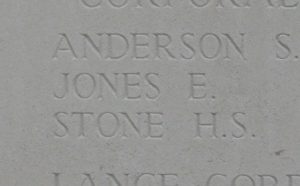
John Isaac Jones, Sapper, 14786726, Royal Engineers. John was the son of Isaac and Sarah Jones, of Machynlleth. He married Anne Elizabeth Jones at Aberystwyth in 1931 and the couple resided at 5, North Road, Aberystwyth, where John worked as a railway labourer. John enlisted into the army soon after the outbreak of war and served with 170 Tunnelling Company, Royal Engineers, a unit that had seen considerable service during the Great War, before being reformed in 1939. John probably served with the unit in France in 1940, before the unit was evacuated to Dunkirk, and moved to Gibraltar. He survived the war but died on 23 August 1946, aged 37. John is buried at Llangynfelyn (St. Cynfelyn) Church Cemetery.
Stanley Jones, Serjeant, 14594404, The Queen’s Royal Regiment (West Surrey). Stanley was the son of Thomas and Anne Jones, of Pennal. He married Ethel Williams, in 1930, and the couple lived at 15, Doll Street, Machynlleth. Ethel had lost her father, William Louis Williams, at Ypres in 1917. Stanley enlisted into the army and was posted to the 1st Battalion, The Queen’s Royal Regiment (West Surrey). The battalion was in India at the start of the war and fought for a year against tribesmen on the North-West Frontier. The battalion then transferred to Burma with the 7th Indian Division to take part in the fighting against the Japanese and saw much action in the Arakan, at Kohima and in the Irrawaddy operations. Stanley died in Burma on 27 July 1945, aged 37, just two months before VE Day. He is buried in Rangoon War Cemetery, Myanmar.
James Howard Latham, Signalman, 14234893, Royal Corps of Signals. James was born on 9 March 1922, the son of William Henry Latham and Annie Elizabeth Latham (nee Thomas), of Machynlleth. He enlisted into the army and was posted to the 17th Lines of Communications Signals, Royal Corps of Signals, together with his friend, William Holt. The role of his unit was to operate signals equipment and also to maintain telephone lines and other communications infrastructure. William embarked for Normandy with his unit at some time after D-Day and took part in the operations to break out of the Normandy beachhead and in the drive through Northern France into Belgium and Holland. He was killed in action around the time of the Rhine crossings, on 1 February 1945, together with his friend, William Holt. James was 22 years old when he was killed that day and is buried in Schoonselhof Cemetery, Belgium.
Idris Gwynfryn Lewis, Private, 7362755, Royal Army Medical Corps. Idris was born on 20 December 1918, the son of Lewis and Margaret Anne Lewis, of Machynlleth. He lived at Talgarth Cottage prior to the war, when he enlisted into the Royal Army Medical Corps. After completing his training, Idris was posted to ‘A’ Company, 132 Field Ambulance, RAMC and was probably posted out to North Africa with the unit, before it took part in the landings in Italy in 1943. Idris died in Italy on 11 October 1944, aged 25. He is buried in Faenza War Cemetery, Italy.
Leonard Maldwyn Lewis, Flight Sergeant, 1653266, Royal Air Force Volunteer Reserve. Leonard was born on 17 December 1923, the son of Richard Albert Lewis and Mary Elizabeth Lewis (nee Evans), of 1, Bank House, Carno. He enlisted into the Royal Air Force Volunteer Reserve, and after training as a Wireless Operator, was posted to 14 Squadron, RAF. The squadron moved to Egypt after the outbreak of war, equipped with the Vickers Wellesley bomber., and took part in missions against the Italian forces before re-equipping with the Bristol Blenheim. The squadron continued its operations against the Italians and Germans over the Western Desert with its new aircraft and in August 1942 converted to the Martin Marauder and later supported the Allied invasions of Sicily and Italy. In September 1944 the squadron transferred back to England and moved to RAF Chivenor, carrying out anti-submarine flights over the Western Approaches and the Bay of Biscay using Vickers Wellington Mk. XIVs. On 24 January 1945, Leonard took off from Chivenor flying Wellington XIV, Serial MF450 on a night exercise. At some time afterwards the aircraft hit the sea, killing five of her crew of six men. Leonard’s body was one of two which were recovered from the sea afterwards. The remains of the 21-year-old were brought home for burial in Machynlleth Nonconformist Cemetery. Leonard is not commemorated on the Machynlleth war memorial.
Geraint Victor Lewis Llewellyn, Gunner, 1477407, Royal Artillery. Geraint was the son of David William Llewellyn and Elizabeth Jane Llewellyn (nee Lewis), of Garthgwynion, Wood Vale, London. His father was a schoolmaster in Catford, and his mother was from Machynlleth, and the family had homes at Catford and also at Galltyllan, Penygoes. Geraint enlisted into the Royal Artillery and after training as a gunner was posted to the 303rd Battery, 94th Light Anti-Aircraft Regiment, Royal Artillery. Geraint died on active service in London on 20 December 1939, aged 21. His body was brought to his mothers native Machynlleth for burial in Machynlleth Nonconformist Cemetery. Geraint is not commemorated on the Machynlleth war memorial.
Bernard John McGinn, Sergeant, 1375485, Royal Air Force Volunteer Reserve. Bernard was the son of Major John Terence McGinn and Winifred Anne McGinn (nee Thomas), of Porthcawl. His parents came to live at Machynlleth prior to the war after his father had been awarded the position of Minister of Labour and National Service. Bernard enlisted into the Royal Air Force Volunteer Reserve and after training as a pilot, was posted to 150 Squadron, RAF, which was based at RAF Snaith and equipped with the Vickers Wellington. During the evening of 28 April 1942, Bernard took off from Snaith aboard Wellington III, Serial X3700, which was part of a large force of bombers sent to bomb targets in Cologne. Bernard was killed when his Wellington crashed into the ground that night. The 21-year-old was originally buried besides his fellow crewmen in a cemetery some eleven miles northwest of Duisburg, but after the war their graves were exhumed and relocated into Rheinberg War Cemetery, Germany.
David Francis Prosser, Fusilier, 4193168, Royal Welch Fusiliers. David was the son of Walter Austin Prosser and Annie Prosser. The family had moved around South Wales before his mother moved to Machynlleth with her children prior to the war. David enlisted into the Royal Welch Fusiliers prior to the war, and probably served with the 53rd (Welsh) Division. The Division was a Territorial Army unit which mobilised for war after the German invasion of Poland and Czechoslovakia, before moving to Northern Ireland on garrison duties. David must have married his wife, Jeannie Prosser, at Newtownards whilst stationed there. The 53rd Division then returned to Britain, initially to Pembroke Dock, before moving to the south of England to train for the forthcoming Normandy landings. David did not embark for Normandy with the Division, however, as he died on 3 July 1944, aged 27. He is buried in Newtownards (Movilla) Cemetery, Northern Ireland.
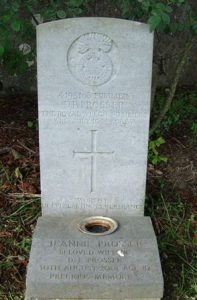
Brian Dominic Rafferty, MC, CdeG, Captain, 129641, Royal Berkshire Regiment. Brian was born in Hull on 1 September 1919, the son of Thomas Austin Rafferty and Keyna Rafferty (nee Rogan). His father was a coal exporter, so Brian and his father often spent time overseas. The family had a home at The Newlands, Machynlleth. Brian was educated at Beaumont and spent his first summer after leaving the school touring Canada, before returning to England to study at Christ Church, Oxford. Brian was only there a year when war erupted, and he gained a commission as Second Lieutenant into the Royal Berkshire Regiment. He then volunteered for service with the newly formed covert group, the Special Operations Executive. Brian, by now a Captain, was initially trained at Wanborough Manor, near Guildford before going through the tough Commando course at Achnacarry. On 24 September 1942 Brian was parachuted into occupied France with another two agents, Sydney Hudson and George Jones, and the trio began organizing and training a number of resistance groups. Sydney Hudson was arrested in October, then during April 1943 Brian was arrested, followed by George Jones and all three men were handed to the Gestapo by the French Gendarmes. Brian was taken to Flossenburg concentration camp, but sadly he was executed there by some SS Guards on 29 March 1945 as the Allies were pushing their way into Germany. Brian was posthumously awarded the Military Cross for his gallantry. He was also later posthumously awarded the French Croix de Guerre at the behest of Charles de Gaulle. Brian was 25 years old when he was murdered by the SS. He has no known grave so is commemorated on the Brookwood 1939-1945 Memorial, Surrey.

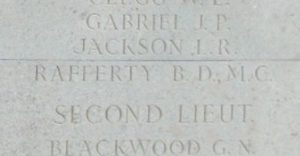
John Edmund Cameron Thompson, DSC, Lieutenant, Royal Navy. John was born at Chester in 1923, the son of Lieutenant Colonel Sir Thomas Raikes Lovet Thompson, MC, and Lady Millicent Ellen Jean Thompson (nee Tennyson-d’eyncourt). John had enlisted into the Royal Navy as a young man in 1937 and had a home at Machynlleth. He joined the Fleet Air Arm and was posted to HMS Merganser, the Royal Naval Air Station near Crimond, Aberdeenshire. The station had opened on 3 October 1944 and served as a training establishment for Telegraphists, Air Gunners and Torpedo Bombing Reconnaissance crews. John was killed on 18 June 1945, when his aircraft was lost whilst on a training flight over the sea. The 21-year-old has no known grave and is commemorated on the Lee-on-Solent Memorial, Hampshire. He had been awarded the Distinguished Service Cross during the war.
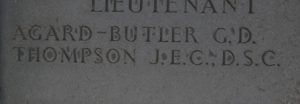
David Richard Vaughan, Stoker 2nd Class, D/KX 527951, Royal Navy. David was born on 2 February 1925, the son of David and Cissy Vaughan, of 28, Graig Fach, Machynlleth. He enlisted into the Royal Navy and married Rachel Johnson was based at Swansea in 1943. David was then posted to HMS Lanka, the Royal Naval Base near Colombo, in Ceylon and embarked aboard the SS Khedive Ismail. The ship stopped off at Malta before heading for the Suez Canal then stopped again at Mombasa, before setting off again for Colombo. Aboard Khedive Ismail were over 1,500 passengers, mostly military personnel, plus a large number of nurses. The ship left Mombasa as part of Convoy KR-8 on 6 February 1944 and was escorted by the heavy cruiser HMS Hawkins and the destroyers HMS Petard and HMS Paladin. In the early afternoon of Saturday 12 February 1944, the Japanese submarine I-27 torpedoed and sank the Khedive Ismail, which went down quickly with the loss of almost 1,300 lives. David was 26 years old when he was killed during the sinking that day and is commemorated on the Plymouth Naval Memorial, Devon.
William Leslie White, Flying Officer, 177840, Royal Air Force Volunteer Reserve. William was born at Bristol on 20 February 1918, the son of Charles William and Ethel White (nee Davis), of Bristol. He married Jean Davies, of Machynlleth, in 1943. William had enlisted into the Royal Air Force Volunteer Reserve and trained as a pilot before being posted to 12 Squadron, RAF. The Squadron was based at RAF Wickenby and was equipped with the Avro Lancaster III. On the night of 29 July 1944 William took off from Wickenby aboard Avro Lancaster III, Serial ND699, which was part of a large force of heavy bombers despatched to bomb targets around Stuttgart. William was killed, together with all his crew, when their Lancaster crashed into the ground at Renningen, near Stuttgart that night. The 26-year-old is buried alongside his fellow crewmen in Durnbach War Cemetery, Germany. William is not commemorated on the Machynlleth war memorial.
Cyril Ellis Williams, Gunner, 1796292, Royal Artillery. Cyril was born on 25 July 1909. He married Cynthia May Jones in South Africa prior to the war and upon returning to Britain the couple lived at30, Treowain, Machynlleth. Cyril enlisted into the Royal Artillery and was posted to the 242nd Battery, 48th Light Anti-Aircraft Regiment, Royal Artillery. The regiment sailed from Gourock for the Far East on 7 December 1941, the day Japan declared war and was initially bound for Basra. After changing ships at Durban, the regiment sailed for the Far East, initially destined for Singapore, but due to the Japanese invasion of the Malay Peninsula, was diverted to Batavia, Java. The regiment was then deployed to guard a number of airfields, but soon Java came under attack by the Japanese and the garrison was surrendered. Cyril was among a large number of Gunners taken prisoner in Java and sent to Sandakan Prisoner of War Camp in Borneo. He reportedly died there of malaria on 6 January 1945. The 35-year-old was originally buried in Sandakan War Cemetery, but all of the burials in the cemetery were exhumed after the war and on 16 June 1949 were re-interred in Labuan War Cemetery, Malaysia.
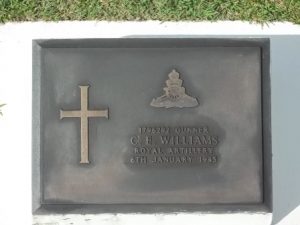
Hugh Thomas Wynne, Gunner, 4205796, Royal Artillery. Hugh was born on 11 November 1911, the son of John Wynne and Jane Wynne (nee Arthur), of Machynlleth. He married Gwen May Davies, of Pennal, in 1939. Hugh enlisted into the Royal Artillery and after completing his training was posted to 380 Battery, 116 Light Anti-Aircraft Regiment, which was attached to the 53rd (Welsh) Division. The Division spent most of the war on home service, but at the end of June 1944 landed in Normandy, to take part in the break-out. The regiment set up its guns soon after arriving in France, to defend against air attack, but it soon became apparent that the Luftwaffe was almost finished, so the regiment was also used against ground targets. Hugh became the first member of the regiment to be killed, losing his life when his battery was shelled on 1 July 1944. He was 32 years old and is buried in Ryes War Cemetery, Bazenville, France.